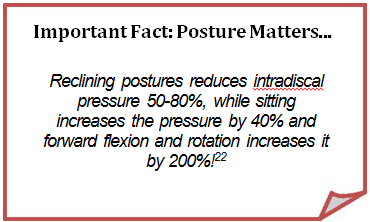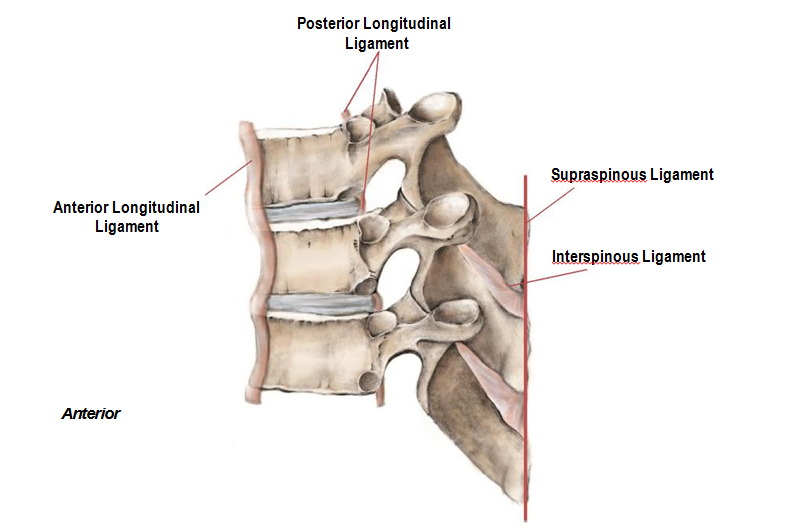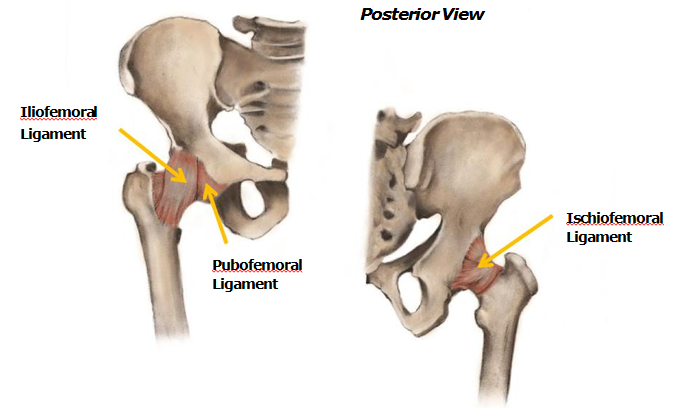Anatomy Review Copy
2.4.1 SPINE
Bony Components:
The basic structure of each spinal segment is composed of two portions: the vertebral body and the vertebral arch. (see Figure 1)
The vertebral body sits ANTERIORLY in the body and are the major weight bearing component of the spine, increasing in size from cervical to lumbar. Between each adjacent vertebral body are fibrocartilaginous intervertebral discs. Spinal curvatures are influenced by the shape of both discs and vertebral bodies. Generally in the thoracic spine, where osteoporotic vertebral fractures typically occur, the vertebral body tends to be wedged anteriorly, or having less height in the anterior portion relative to the posterior portion. The shape of the vertebral body as well as the disc contributes to the natural primary curvature (kyphosis) which exists in the thoracic region. This characteristic is more prevalent in the mid-thoracic region.7
The vertebral arch is comprised of two bony struts and three processes which make up the lateral and posterior aspects of the vertebral column. Directly connected to the vertebral body are two bony pillars on either side, called pedicles. (see Figure 1) Extending posteriorly and medially from each pedicle are two flat sheets of bone called the laminae. The two laminae meet in the midline posteriorly. Extending laterally and slightly posteriorly at the junction of the pedicle and lamina on either side is a transverse process. The transverse processes provide important bony attachment points for muscles and ligaments and in particular in the thoracic region, for articulation with the ribs. Extending posteriorly and inferiorly, from the junction of the two laminae, is the spinous process. Similar to the transverse processes, this provides an important articulation site for muscles and ligaments.
The final bony prominences extending near the juncture of the pedicle and laminae are the articular facets, sometimes referred to collectively as the zygopophyseal joints (or z-joints). There are two processes on each side – one superior and one inferior. Each superior facet articulates with the inferior facet of the vertebrae above it thus creating that z-joint, and is the main component which dictates the movement for that spinal segment. The superior and inferior articulating process in the thoracic region face relatively posteriorly and anteriorly, respectively. Therefore, the movements predominantly allowed throughout the thoracic movement are rotation and side bending with minimal flexion and extension between each segment. Given that there are 12 segments, the total flexion or extension across the thoracic region could between 24 and 36 degrees.
Ligamentous Components:
The vertebral bodies and components of the vertebral arches are reinforced and connected to segments above and below by many ligamentous reinforcements. Each spinous process has two main ligaments, one set of ligaments that run in-between each subsequent spinous process – the interspinous ligament and another ligament that runs nearly the length of the column, joining tip to tip – the supraspinous ligament. (see Figure 2) From the skull to C7, the supraspinous ligament spreads out in the midsagittal plane to become a distinct sheet-like ligament called the ligamentum nuchae. The purpose of these ligaments are to limit the amount of flexion and potentially to assist a return to neutral posture (a type of ligamentous rebound).
Ligaments between each transverse process – the intertransverse ligaments – help to limit side flexion and excessive rotation. The final ligament attaching to the vertebral arch is the ligamenta flava, a highly elastic ligament which attaches lamina to lamina. The main function of this ligament is to again resist excessive flexion and assist in the return to an anatomical position in extension. (see Figure 2)
Intervertebral Disc:
Besides the z-joints, a movement segment for the vertebral column is the symphysis between the vertebral bodies, otherwise known as the intervertebral disc. The disc is composed of two parts – an outer collagenous ring surrounding a central gelatinous portion. (see Figure 2) The annulus fibrosus is composed of many layers of fibrocartilaginous lamellae which have the main function of limiting rotation between vertebrae. The nucleus pulposus, the jelly-like centre of the disc serves to help resist compressive forces placed through the vertebrae.

Muscular Components:
Muscles acting on the spine can be divided into 2 main parts: an appendicular group and an intrinsic group. The appendicular group is composed of those muscles which attach to the upper limb and back and therefore act indirectly on the back. The group includes the rhomboids (major and minor), trapezius, latissimus dorsi, and levator scapulae. The location of these muscles can be reviewed on Figure 3.
The intrinsic group of back muscles are those that originate and insert within the torso. They are deep to the appendicular group and can further be subdivided into two groups: the erector spinae group and the transversospinalis group deep to the erector spinae muscles.
The erector spinae muscles are three long bands from most medial to lateral: the spinalis, longissimus and iliocostalis muscles. This group broadly arises from the sacrum, iliac crest, and spinous processes of the lower thoracic and lumbar vertebrae.(Figure 4) The most medially located band is the spinalis which connects spinous processes of adjacent vertebrae and are most plentiful in the thoracic region. The middle band, the longissimus is the largest portion, extending the entire spine and tends to be positioned over the transverse processes. The most lateral column is the ilicostalis and spreads out from the iliac crest to the ribs up to the lower cervical transverse processes. The function of this group is to side flex the spine when unilaterally activated and is the primary back extensor when contracted bilaterally. It also can help control spine flexion through controlled contractions.
The transversospinalis group gains its name from its muscle attachments, running up & medially from transverse process to spinous process. It is comprised of three major subgroups: the semispinalis, multifidus, and rotatares. The semispinalis is the most superficial of the group, starting in the lower thoracic region ending at the skull. Generally this muscle spans 4-6 vertebrae from origin to insertion. Deep to the semispinalis is the multifidus which runs the length of the entire column but is most developed in the lumbar region. Generally this muscle spans 2-4 vertebrae from origin to insertion. The deepest group is the rotatores muscles. Best developed in the thoracic region (which makes sense as this is where most rotation occurs!), they are present in all parts of the spine. These fibres are generally very short and pass only 1-2 segments.
The function of this muscle group is similar to the erector spinae group in that bilateral contraction results in back extension and unilateral contraction results in side flexion. This group has more control of rotary action as well, given its angulated deep attachment and smaller segmental spanning when unilaterally contracted.
VERTEBRAL ANATOMY FIGURES

Anterior
Figure 1: Typical thoracic vertebra

Figure 2: Ligamentous structures of spinal column

Figure 3: Superficial Back Muscles

Figure 4: Deep Back Muscles
2.4.2 HIP
Bony Components:
The hip joint is comprised of two portions: the head of the femur and the pelvic acetabulum. The spherical head of the femur features a fovea which is non-articular and is the attachment point for the ligament of the head of the femur. This ligament forms a protective sheath for a small branch of the obturator artery which supplies the femoral head. The acetabulum nearly entirely surrounds the head of the femur, thus making this joint highly stable. Around the rim of the acetabulum there is a fibrocartilaginous collar, the acetabular labrum which spans a deficiency of the labrum (acetabular notch) as the transverse acetabular ligament.
Extending laterally and inferiorly from the head of the femur to join the shaft of the femur at an angle of approximately 125 degrees is the neck of the femur. It is this orientation of the neck to the shaft which allows for great range of motion in the hip joint. (see Figure 1)
Ligamentous Components:
The hip, like all synovial joints, is surrounded by a fibrous capsule but is unique in that this capsule contains three thickenings which are interpreted as the ligaments of the hip.(see Figure 2) The three ligaments together all spiral around the femoral neck and head from posterior to anterior, such that they all become taut in extension and assist in the passive support of the joint during standing.
Most anteriorly is the iliofemoral ligament, which is shaped like an inverted Y, with the stem coursing down from the AIIS and the stems of the letter A spreading out along the intertrochanteric line of the femur. Its main function is to resist excessive hip extension and external rotation. The pubofemoral ligament is positioned more anterior and inferior to the hip, passing from the iliopubic eminence to blend laterally with the deep surface of the iliofemoral ligament. The function o f this ligament in addition to resisting extension is to limit abduction of the hip joint. Finally, the ischiofemoral ligament passes forward from its attachment to the ischium to attach laterally to the greater trochanter. This ligament mainly functions to resist extension or hyperextension. This ligamentous arrangement essentially leaves the posterior aspect of the femoral head unreinforced and thus susceptible to posterior dislocation.
Musculature of the Hip:
The hip has many muscles acting upon it to produce its multiple movements: flexion, extension, medial & lateral rotation, abduction, adduction and circumduction. The muscles can be grouped by region: posterior, anterior, and medial. (Figure 3)
The posterior group is comprised of superficial and deep gluteal muscles and the hamstrings trio. Gluteus maximus superficially covers all other gluteal muscles and has a broad attachment into the iliotibial band from the ilium, sacrum and sacrospinous ligament. Its main functions are to extend the hip and laterally rotate. The hamstrings, comprised of biceps femoris, semitendinosus and semimebranosus also help to extend the hip.
Gluteus medius & minimus extend from the posterior surface of the ilium to the greater trochanter of the femur. These muscles, along with the tensor fascia lata, abduct and medially rotate the hip. The mneumonic rhyme used is often: “TFL, gluteus med & min all abduct the hip and rotate in!”
There are 6 deep muscles in the gluteal region which all have the main action to laterally rotate the hip. These are, from superior to inferior: piriformis, gemellus superior, obturator internus, gemellus inferior, obturator externus, and quadratus femoris.
Anteriorly, the muscles act on the hip to produce flexion, and include the iliopsoas, rectus femoris, sartorius and pectineus. Medially, muscles producing hip adduction include adductor brevis, longus, magnus, pectineus, and gracilis.

Figure 1: Bony Features of the Hip

Figure 2: Ligaments of the Hip

Figure 3: Muscle Groups acting on the Hip